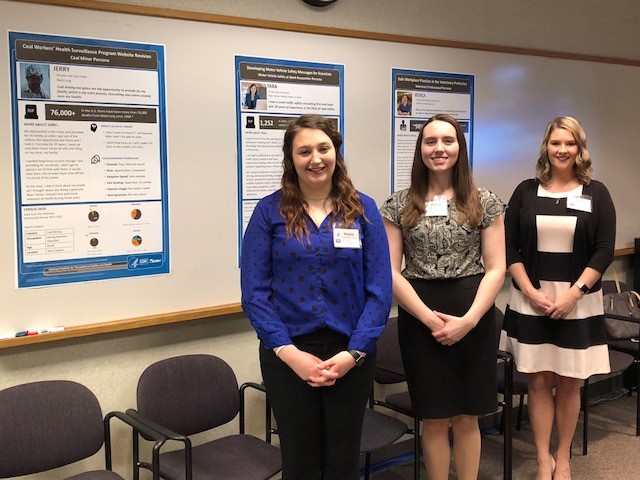Graduate Students Use Coursework to Provide Health Communication Support on NIOSH Projects
Posted on byEarlier this month three students enrolled in a graduate-level health communication class at West Virginia University delivered presentations on NIOSH-related projects that they completed as part of their coursework. As part of their projects, students used health communication, social marketing, health literacy, and web design principles and best practices. Summaries of the student projects and their personal experiences working on current health communication opportunities follow.

Coal Workers’ Health Surveillance Program Website Revision
Gabrielle Henry
NIOSH’S Coal Workers’ Health Surveillance Program (CWHSP) was developed in 1970 due to the Coal Mine Health and Safety Act. The CWHSP website offers information about the program along with free lung screenings to coal miners. However, the website for this program can be difficult to navigate and has complex information that does not meet the needs of coal miners.
The main objective for this project was to revise the CWHSP website to make information and navigation easy for coal miners and their families. Methods used to achieve this objective included: an interview with the CWHSP Program Coordinator, viewing the Faces of Black Lung video, performing card sorting, conducting website usability testing, creating a wireframe, and assessing the reading level of content on the site. Results included barriers, benefits, and motivators related to coal miners and the CWHSP program; a new menu structure; health literacy scores for each webpage; and a wireframe of the CWHSP main webpage. Suggestions for the design of the website were given along with ideas for future consideration.
“One of the most rewarding aspects of this class was the actual experience of working on a ‘real world’ health problem. This project allowed me to step outside of the classroom setting to accomplish tasks I never had experience with. Hearing feedback from the NIOSH staff who work with the CWHSP, and that they may implement some of my ideas in the future was especially rewarding,” said Gabrielle.
Using Health Communication and Health Literacy Strategies to Create a User-Friendly Motor Vehicle Safety at Work Website
Elly Myers
Three researchers with interest in work-related motor vehicle safety were interviewed to learn about their needs, experiences, behaviors, and goals when visiting the NIOSH Motor Vehicle Safety at Work webpages. Feedback gleaned from the researchers was used to provide recommendations on how to best reorganize and edit the site’s content. Overall, the researchers appreciated the Motor Vehicle Safety at Work website’s “quick and fast” fact sheets and their credible data.
In addition to the interviews, other usability and readability methods were used to further demonstrate revisions needed for the current website. These other methods included card sorting, a pros and cons analysis of other motor vehicle safety websites, website usability testing, and assessing reading levels. Suggestions for website usability improvements and a website wireframe were presented to NIOSH employees and Center for Motor Vehicle Safety staff.
According to Elly, the most rewarding aspect of the course was presenting to the NIOSH employees. “Staff listened intently to our input and expressed their excitement to read the formal report, which outlined the health communication problem, methodology, results, limitations, and future recommendations. At the end of the day, we were treated as colleagues rather than students.”
Safe Workplace Practices in the Veterinary Profession
Kylie Wilson
The purpose of this study was to understand veterinary professionals’ perceptions about current workplace practices, and to determine potential communication channels and training opportunities for reaching such professionals with important workplace practice information, specifically as it related to the handling of hazardous drugs and materials. To do this, focus group discussions and in-depth interviews were conducted with veterinary professionals in Morgantown, WV. Findings revealed veterinary professionals:
- had not received formal training in safe workplace practices
- do not believe disease is spread through contact with animals
- receive important information from their office administrator
- will likely not complete training if there is a time commitment outside of working hours or training is expensive
Based on the findings, an online course is recommended for veterinary professionals. This course should be interactive, discuss safe workplace practices associated with hazardous drugs and material handling, and other topics, including: differences between human and animal healthcare and how to control exposure.
“This project was different than anything I have ever experienced. It was very interesting to get real world experience and work with an organization like NIOSH,” said Kylie. “It was also interesting to hear various perspectives about workplace practices. Working on this project made me excited for future work in the field upon graduation.”
NIOSH is interested in your experience working with students. How have you or your organization collaborated with students to give them opportunities to participate in the occupational safety and health field?
Gabrielle Henry, MPH Candidate, WVU School of Public Health
Elly Myers, MPH Candidate, WVU School of Public Health
Kylie Wilson, Doctoral Student, WVU Department of Communication Studies
Posted on by

